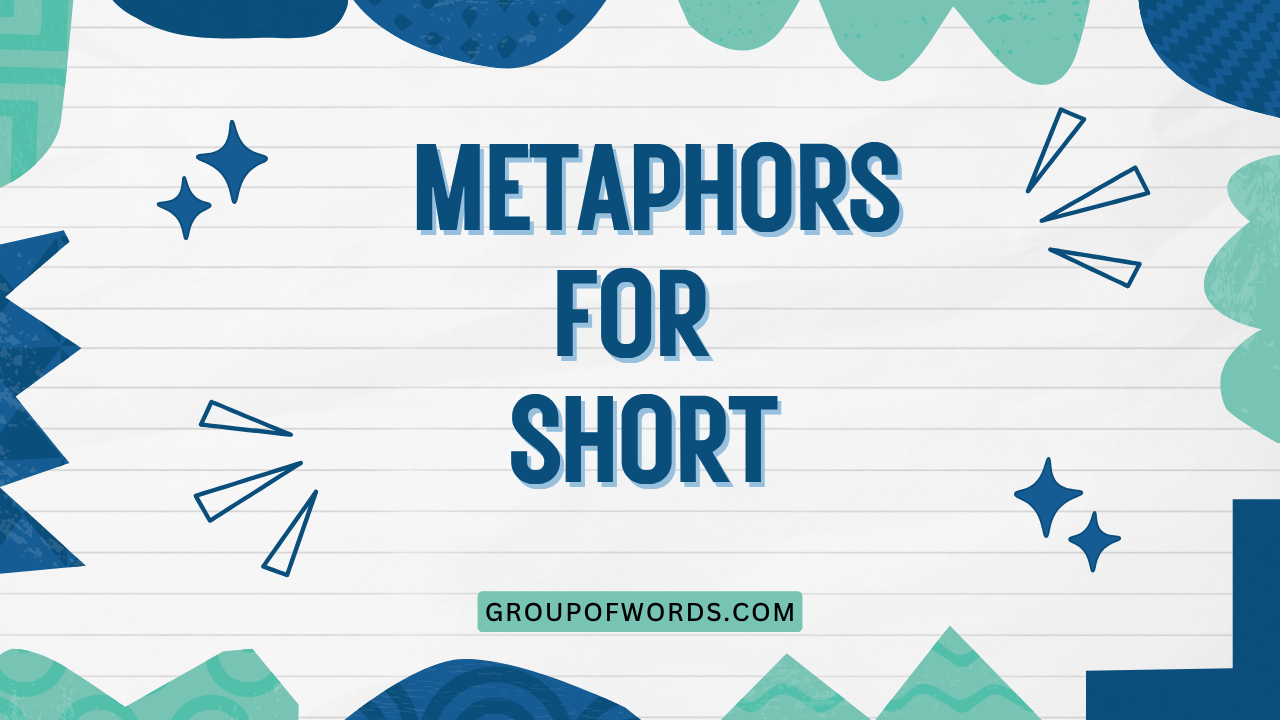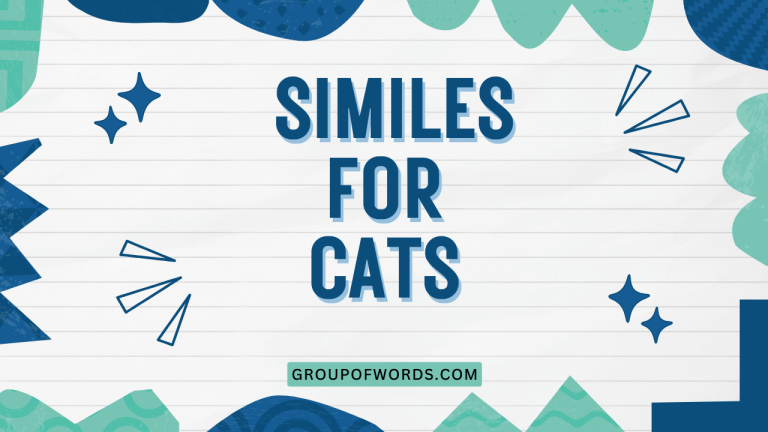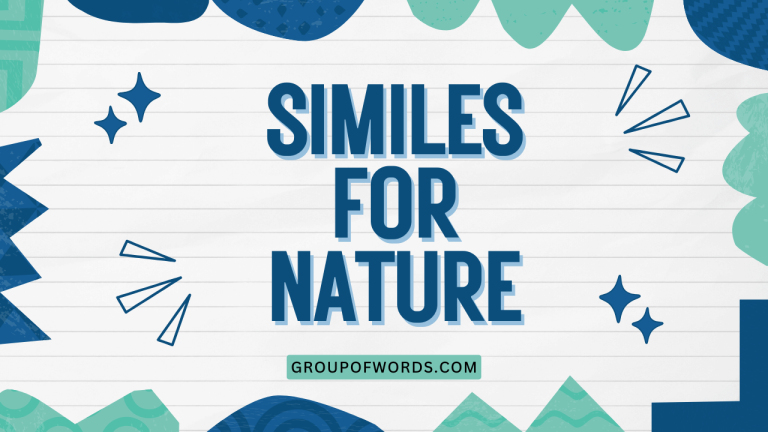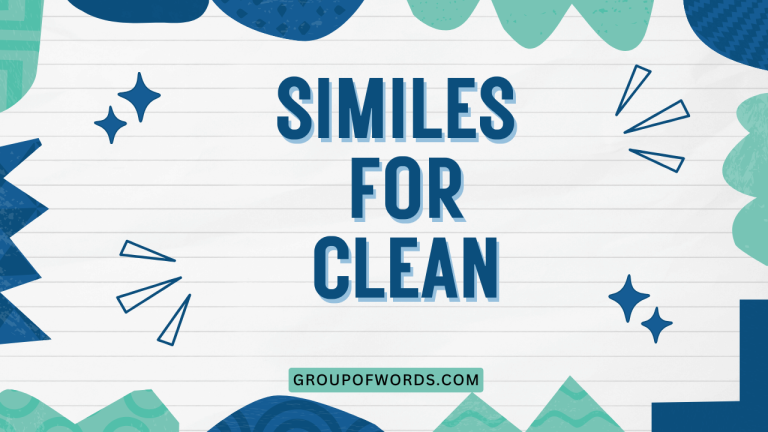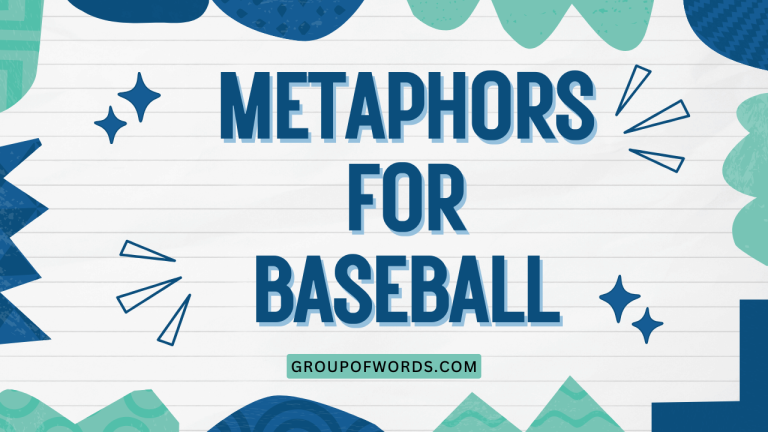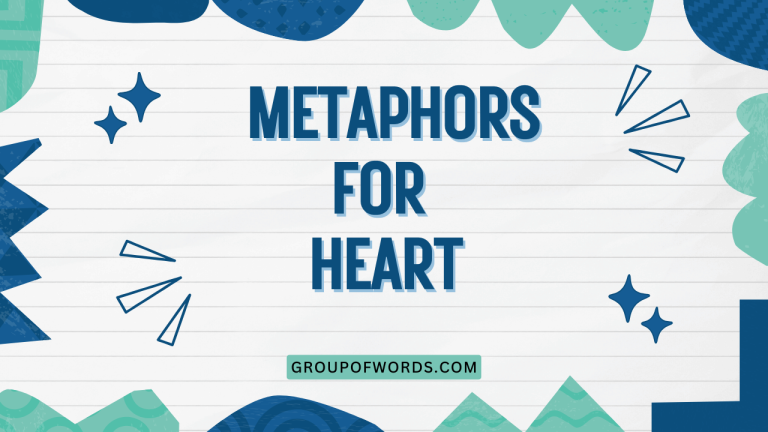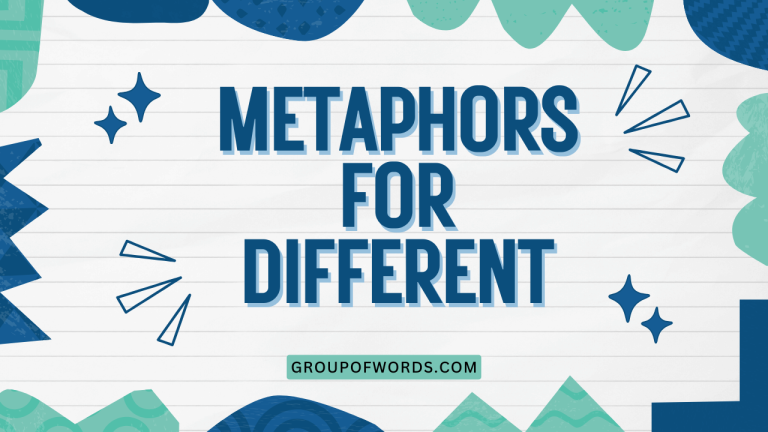Metaphors for Short: Expressing Brevity in English
Understanding how to express the concept of “short” in English extends far beyond simply using the adjective itself. Metaphors allow us to add color, nuance, and depth to our descriptions, making our language more engaging and precise.
This article explores various metaphors for “short,” examining their meanings, structural components, and appropriate contexts. Whether you’re an ESL student aiming to enhance your vocabulary or a native speaker looking to refine your expressive abilities, this guide offers a comprehensive understanding of metaphorical brevity.
This exploration will cover diverse metaphorical expressions, from time-related idioms to spatial analogies, providing you with a rich toolkit for conveying the idea of shortness. We will delve into idiomatic expressions, similes, and other figurative language devices.
This article is designed for English language learners, writers, and anyone interested in expanding their understanding of English vocabulary and figurative language.
Table of Contents
- Introduction
- Definition of Metaphors for “Short”
- Structural Breakdown of Metaphors
- Types and Categories of Metaphors for “Short”
- Examples of Metaphors for “Short”
- Usage Rules for Metaphors for “Short”
- Common Mistakes When Using Metaphors for “Short”
- Practice Exercises
- Advanced Topics
- FAQ
- Conclusion
Definition of Metaphors for “Short”
A metaphor is a figure of speech that directly compares two unlike things, implying a similarity between them without using “like” or “as.” When we use metaphors for “short,” we are employing figurative language to express the idea of brevity in terms of duration, length, or extent. These metaphors go beyond the literal meaning of “short” to invoke vivid imagery and deeper understanding.
The function of these metaphors is to make language more expressive, engaging, and sometimes, more concise.
Metaphors for “short” can be classified based on what they draw the comparison from. For instance, some metaphors may originate from the realm of time (e.g., “a flash in the pan”), while others may come from spatial concepts (e.g., “a sliver of time”).
The context in which these metaphors are used is crucial; the same metaphor might have different connotations depending on the situation. It’s important to understand the underlying meaning and cultural implications attached to each metaphor to use them effectively.
For example, consider the metaphor “life is a fleeting dream.” This doesn’t literally mean life is a dream, but it uses the ephemeral quality of a dream to emphasize the brevity and transient nature of life. Similarly, “a blink of an eye” paints a vivid picture of extreme speed and brevity, far more impactful than simply saying something happened “quickly.” The goal of using these metaphors is to add depth, emotion, and imagery to your communication, making it more memorable and effective.
These metaphors are often used in literature, poetry, everyday conversation, and even technical writing to add impact and clarity.
Structural Breakdown of Metaphors
Understanding the structure of metaphors helps in both interpreting and creating them. A basic metaphor consists of two main elements: the tenor and the vehicle. The tenor is the subject being described, and the vehicle is the object or concept used to describe the tenor. The connection between the tenor and the vehicle is the ground, which is the shared characteristic that makes the comparison relevant.
In the metaphor “time is a thief,” the tenor is ‘time,’ and the vehicle is ‘a thief.’ The ground is the shared characteristic of taking something away – time steals moments, and a thief steals possessions. Understanding this structure allows us to analyze how metaphors work and how they create meaning.
The effectiveness of a metaphor often depends on how well the ground resonates with the audience and how vividly the vehicle represents the tenor.
Metaphors for “short” often follow a similar pattern. For example, in the phrase “a whirlwind romance,” the tenor is the ‘romance,’ and the vehicle is ‘a whirlwind.’ The ground is the shared characteristic of being fast, intense, and fleeting.
Recognizing these structural components empowers you to deconstruct and appreciate the nuances of metaphorical language, and it also helps you construct your own effective metaphors.
Types and Categories of Metaphors for “Short”
Metaphors for “short” can be categorized based on the domain from which they draw their comparison. Here, we examine time-related, spatial, quality-related, quantity-related, and event-related metaphors.
Time-Related Metaphors
Time-related metaphors describe brevity by comparing it to short durations or fleeting moments. These metaphors often emphasize the transient nature of the subject.
Common examples include phrases like “a flash in the pan,” “a blink of an eye,” and “a fleeting moment.” These metaphors are particularly effective for describing experiences, events, or feelings that are quick and ephemeral.
Consider the phrase “a flash in the pan.” It originates from the idea of a quick, bright burst of light followed by nothing, used to describe something that shows initial promise but quickly fails to deliver. Similarly, “a blink of an eye” highlights the speed at which something occurs, emphasizing its brevity.
These metaphors add a sense of urgency and transience to the description.
Spatial Metaphors
Spatial metaphors use physical dimensions or locations to convey the idea of shortness. They often relate to length, distance, or size, providing a tangible comparison to the subject.
Examples include “a sliver of time,” “a brief interlude,” and “a short distance.” These metaphors are useful when describing the extent or scope of something that is limited or constrained.
The phrase “a sliver of time” conjures an image of a very thin, narrow piece, suggesting a small amount of time. “A brief interlude” uses the idea of a short break or pause to emphasize the limited duration of an event or experience.
These spatial metaphors provide a concrete way to visualize the concept of shortness, making it more relatable and understandable.
Quality-Related Metaphors
Quality-related metaphors describe shortness by associating it with qualities or characteristics that imply brevity. These metaphors often focus on the intensity, impact, or nature of the subject.
Examples include “a whirlwind romance,” “a quick study,” and “a passing phase.” These metaphors are effective for describing experiences, relationships, or skills that are characterized by speed or transience.
A “whirlwind romance” suggests a fast-paced, intense relationship that may not last long. “A quick study” describes someone who learns quickly, emphasizing their ability to grasp new information in a short amount of time.
“A passing phase” implies a temporary state or condition. These metaphors use qualities like intensity and speed to convey the idea of shortness in a more nuanced way.
Quantity-Related Metaphors
Quantity-related metaphors use numerical or measurable terms to express the idea of shortness. These metaphors often involve comparing the subject to a small amount or a limited quantity.
Examples include “a drop in the ocean,” “a handful of moments,” and “a mere fraction.” These metaphors are useful for emphasizing the insignificance or limited scope of something.
“A drop in the ocean” suggests something is so small that it is almost negligible compared to the whole. “A handful of moments” emphasizes the limited number of moments involved.
“A mere fraction” implies that only a small part of something is being considered. These metaphors use quantity to highlight the concept of shortness, often with a sense of understatement or insignificance.
Event-Related Metaphors
Event-related metaphors describe shortness by comparing it to events that are known for their brevity or speed. These metaphors often involve actions or occurrences that highlight the transient nature of the subject.
Examples include “a sprint to the finish,” “a pit stop,” and “a fly-by.” These metaphors are effective for describing processes, activities, or situations that are characterized by speed and efficiency.
“A sprint to the finish” suggests a quick, intense burst of effort towards a goal. “A pit stop” implies a brief pause or interruption in a longer process.
“A fly-by” describes a quick passing or inspection. These metaphors use the imagery of specific events to convey the idea of shortness in a dynamic and engaging way.
Examples of Metaphors for “Short”
Here are some examples of metaphors used to describe “short,” categorized for clarity. Each table contains a variety of examples to illustrate the different nuances and contexts in which these metaphors can be used.
Table 1: Time-Related Metaphors
This table presents time-related metaphors, focusing on their meanings and example sentences showcasing their usage in different contexts. Understanding these metaphors will help you convey the brevity of time in a more impactful way.
| Metaphor | Meaning | Example Sentence |
|---|---|---|
| A flash in the pan | Something that shows initial promise but quickly fails. | His success was just a flash in the pan; he couldn’t sustain it. |
| A blink of an eye | A very short period of time. | The opportunity disappeared in the blink of an eye. |
| A fleeting moment | A brief and transient period. | It was just a fleeting moment of happiness. |
| A split second | An extremely short interval of time. | He reacted in a split second, saving the child. |
| A quick minute | A very short amount of time. | I’ll be back in a quick minute. |
| A passing second | A brief and transient second. | Every passing second felt like an eternity. |
| A brief instant | A very short moment. | In that brief instant, everything changed. |
| A momentary lapse | A short period of forgetfulness or inattention. | It was just a momentary lapse in judgment. |
| A snapshot of time | A brief glimpse or representation of a particular moment. | The photograph provided a snapshot of time from the 1950s. |
| A heart beat | An extremely short interval of time. | His heart beat fast when he saw her. |
| A nanosecond | An extremely short interval of time. | The computer process the data in a nanosecond. |
| A fragment of time | A very small piece of time. | He spent a fragment of time reading the book. |
| A split-hair second | An extremely short interval of time. | He won the race by a split-hair second. |
| A twinkle of an eye | A very short period of time. | The star disappeared in a twinkle of an eye. |
| A whiff of air | An extremely short interval of time. | The scent of lavender lingered for a whiff of air. |
| A snap of fingers | A very short period of time. | He got the promotion in a snap of fingers. |
| A trice | An extremely short interval of time. | I’ll be there in a trice. |
| A jiffy | A very short period of time. | I’ll finish the work in a jiffy. |
| A shake of a lamb’s tail | An extremely short interval of time. | He was gone in a shake of a lamb’s tail. |
| A cat’s wink | A very short period of time. | He fell asleep in a cat’s wink. |
Table 2: Spatial Metaphors
This table explores spatial metaphors for “short,” highlighting how they use physical dimensions to convey brevity. The examples provided illustrate how spatial comparisons can make the concept of shortness more tangible and relatable.
| Metaphor | Meaning | Example Sentence |
|---|---|---|
| A sliver of time | A very small amount of time. | I only had a sliver of time to complete the task. |
| A brief interlude | A short break or pause. | The rain provided a brief interlude in the heat. |
| A short distance | A limited length or extent. | It’s just a short distance from here to the store. |
| A narrow margin | A small difference or degree. | They won the election by a narrow margin. |
| A limited space | A restricted area or extent. | There was a limited space for parking. |
| A tiny corner | A small and confined area. | He found peace in a tiny corner of the garden. |
| A shallow depth | A limited level or extent. | The river had a shallow depth near the bank. |
| A slim chance | A small possibility. | He had a slim chance of winning the lottery. |
| A small extent | A limited scope or range. | The damage was only to a small extent. |
| A hairline fracture | A very thin crack. | The vase had a hairline fracture and a small chip. |
| A pinprick of light | A very small point of light. | In the darkness, there was just a pinprick of light. |
| A mere thread | A very small amount or connection. | He held on by a mere thread. |
| A speck of dust | An extremely small particle. | There was not a speck of dust in the room. |
| A drop in the bucket | A very small amount compared to the whole. | His contribution was just a drop in the bucket. |
| A touch of frost | A very light layer of frost. | There was just a touch of frost on the grass. |
| A grain of sand | A very small particle. | Each grain of sand is unique. |
| A shadow of doubt | A very small amount of doubt. | There was a shadow of doubt in his mind. |
| A whisper of wind | A very light breeze. | There was just a whisper of wind in the trees. |
| A hint of color | A very slight trace of color. | There was a hint of color in her cheeks. |
| A touch of sadness | A very slight feeling of sadness. | There was a touch of sadness in his eyes. |
Table 3: Quality-Related Metaphors
This table showcases quality-related metaphors for “short,” demonstrating how associating brevity with specific qualities can enhance descriptions. The examples illustrate the various ways in which qualities like intensity, speed, and transience can be used to convey the idea of shortness.
| Metaphor | Meaning | Example Sentence |
|---|---|---|
| A whirlwind romance | A fast-paced and intense relationship. | They had a whirlwind romance and got married within a month. |
| A quick study | Someone who learns quickly. | She’s a quick study and picked up the new software easily. |
| A passing phase | A temporary state or condition. | His rebellious behavior was just a passing phase. |
| A brief encounter | A short and often unplanned meeting. | Their brief encounter left a lasting impression. |
| A short fuse | A tendency to get angry easily. | He has a short fuse and often overreacts. |
| A fast track | A quick route to success or advancement. | She was on the fast track to promotion. |
| A swift resolution | A quick and efficient solution. | The problem was resolved with a swift resolution. |
| A rapid response | A quick and immediate reaction. | The company issued a rapid response to the crisis. |
| A fleeting glimpse | A quick and transient view. | He caught a fleeting glimpse of her in the crowd. |
| A quick fix | A temporary and often inadequate solution. | The patch was just a quick fix, not a permanent solution. |
| A hasty decision | A quick and often ill-considered decision. | His hasty decision led to negative consequences. |
| A sharp turn | A quick and abrupt change in direction. | The car made a sharp turn. |
| A brisk walk | A quick and energetic walk. | They took a brisk walk in the park. |
| A zippy car | A car that is moving quickly. | He drives a zippy car. |
| A speedy recovery | A quick and complete recovery from illness. | Her speedy recovery surprised everyone. |
| A prompt reply | A quick and immediate response. | He sent a prompt reply to my email. |
| A sudden change | A quick and unexpected alteration. | There was a sudden change in weather. |
| A hasty retreat | A quick and disorganized withdrawal. | They made a hasty retreat from the battlefield. |
| A snappy dresser | Someone who dresses quickly and stylishly. | He’s a snappy dresser. |
| A brisk pace | A quick and energetic pace. | They set a brisk pace to finish the race. |
Table 4: Quantity-Related Metaphors
This table provides examples of quantity-related metaphors, illustrating how numerical or measurable terms can be used to express shortness. These metaphors emphasize the limited scope or insignificance of something, providing a unique perspective on brevity.
| Metaphor | Meaning | Example Sentence |
|---|---|---|
| A drop in the ocean | A very small amount compared to the whole. | His contribution was just a drop in the ocean of what was needed. |
| A handful of moments | A limited number of moments. | They shared just a handful of moments together. |
| A mere fraction | Only a small part of something. | He received a mere fraction of the profits. |
| A small percentage | A limited proportion or amount. | Only a small percentage of students passed the exam. |
| A limited edition | A product or item produced in a small quantity. | The book was released in a limited edition. |
| A few seconds | A small number of seconds. | It only took a few seconds to complete the task. |
| A minimal amount | The smallest possible quantity. | He used a minimal amount of water to wash the car. |
| A slim margin | A small difference or degree. | The team won by a slim margin. |
| A touch of spice | A small or little amount of spice. | A touch of spice adds flavor to the dish. |
| A shade of gray | A small or little amount of gray. | The painting was a shade of gray. |
| A speck of hope | A small or little amount of hope. | There was a speck of hope in his heart. |
| A wisp of smoke | A small or little amount of smoke. | A wisp of smoke rose from the chimney. |
| A fragment of truth | A small or little amount of truth. | There was a fragment of truth in his tale. |
| A grain of salt | A small or little amount of salt. | Take his words with a grain of salt. |
| A whisper of sound | A small or little amount of sound. | A whisper of sound came from the other room. |
| A sliver of moon | A small or little amount of moon. | A sliver of moon shone in the sky. |
| A breath of fresh air | A small or little amount of fresh air. | The trip was a breath of fresh air. |
| A taste of honey | A small or little amount of honey. | He had a taste of honey. |
| A dash of color | A small or little amount of color. | A dash of color brightened the room. |
| A pinch of salt | A small or little amount of salt. | Add a pinch of salt to the mixture. |
Table 5: Event-Related Metaphors
This table explores event-related metaphors for “short,” showcasing how comparisons to specific events can effectively convey brevity. The examples provided illustrate how these metaphors use the imagery of dynamic processes to describe shortness.
| Metaphor | Meaning | Example Sentence |
|---|---|---|
| A sprint to the finish | A quick, intense burst of effort towards a goal. | It was a sprint to the finish as the deadline approached. |
| A pit stop | A brief pause or interruption in a longer process. | The meeting was just a pit stop before getting back to work. |
| A fly-by | A quick passing or inspection. | The plane made a fly-by over the airfield. |
| A quick turnaround | A fast and efficient process. | The company achieved a quick turnaround in sales. |
| A flash flood | A sudden and brief surge of water. | The town experienced a flash flood after the heavy rain. |
| A rapid transit | A quick and efficient transportation system. | The city needs a rapid transit system to reduce traffic. |
| A short circuit | A malfunction that causes a sudden stop. | The device experienced a short circuit and shut down. |
| A swift kick | A quick and forceful action. | She gave the door a swift kick. |
| A rapid ascent | A quick and steep climb. | He had a rapid ascent in his career. |
| A quick dip | A quick and short swim. | Let’s go for a quick dip in the pool. |
| A hasty exit | A quick and disorganized departure. | He made a hasty exit from the party. |
| A swift blow | A quick and forceful attack. | He delivered a swift blow to his opponent. |
| A fleeting visit | A quick and brief stay. | She paid a fleeting visit to her hometown. |
| A quick bite | A quick and small meal. | Let’s grab a quick bite before the movie. |
| A sudden stop | A quick and immediate cessation. | The car came to a sudden stop. |
| A swift execution | A quick and efficient implementation. | The plan went through a swift execution. |
| A quick review | A quick and brief inspection. | He give a quick review of the document. |
| A rapid deployment | A quick and fast set up. | The team went through a rapid deployment. |
| A sudden burst | A quick and unexpected surge. | There was a sudden burst of laughter. |
| A swift reaction | A quick and immediate response. | The medicine caused a swift reaction. |
Usage Rules for Metaphors for “Short”
Using metaphors effectively requires understanding the rules that govern their proper use. The primary rule is to ensure that the comparison between the tenor and the vehicle is relevant and meaningful.
An inappropriate or illogical comparison can lead to confusion or misinterpretation. Also, it is important to maintain consistency within the metaphor.
Mixing metaphors can create a jarring and nonsensical effect.
Consider the metaphor “time is a river.” This comparison is effective because it highlights the flowing, continuous nature of time. However, if you were to mix this with another unrelated metaphor, such as “time is a thief in the night,” you would create a confusing and inconsistent image.
The key is to choose metaphors that align with the intended meaning and context.
Another important rule is to be mindful of the audience. Different cultures and age groups may interpret metaphors differently.
What resonates with one audience may not resonate with another. Therefore, it is crucial to consider the background and understanding of your audience when selecting and using metaphors.
Overusing metaphors can also diminish their impact. Use them sparingly and strategically to maximize their effect.
Common Mistakes When Using Metaphors for “Short”
Several common mistakes can undermine the effectiveness of metaphors. One frequent error is using clichéd metaphors that have lost their impact through overuse.
Phrases like “a drop in the bucket” or “a blink of an eye,” while valid, can sound unoriginal if not used in a creative context. Strive for fresh and imaginative metaphors that capture the reader’s attention.
Another mistake is using mixed metaphors, which combine inconsistent images or ideas. For example, saying “He burned the midnight oil to climb the ladder of success” combines the image of burning oil (studying late) with climbing a ladder (achieving success), creating a nonsensical picture.
It’s better to stick to a single, coherent image.
A further mistake is choosing metaphors that are too obscure or complex for the audience to understand. The goal of a metaphor is to clarify and enhance understanding, not to confuse or alienate the reader.
Ensure that the comparison is clear and relatable. Finally, using metaphors inappropriately in formal or technical writing can detract from the clarity and precision of the message.
Reserve metaphors for contexts where they add value and avoid them in situations where literal language is more appropriate.
Here are some examples of common mistakes with corrections:
| Incorrect | Correct | Explanation |
|---|---|---|
| The project was a drop in the ocean, but it also moved mountains. | The project was a drop in the ocean. | Mixing metaphors (drop in the ocean vs. moving mountains) creates confusion. |
| Her career was a flash in the pan, and she was also a rising star. | Her career was a flash in the pan. | Combining contradictory metaphors (flash in the pan vs. rising star) is illogical. |
| Time is a river flowing uphill. | Time is a fast-flowing river. | The comparison of a river flowing uphill is illogical and confusing. |
| The meeting was a pit stop and a marathon all at once. | The meeting was a quick pit stop. | Inconsistent metaphors (pit stop vs. marathon) create a contradictory image. |
| His speech was a handful of moments that stretched for miles. | His speech was a handful of moments. | The phrase “stretched for miles” does not fit well with the phrase “handful of moments”. |
Practice Exercises
Test your understanding of metaphors for “short” with these practice exercises. Each exercise challenges you to identify, interpret, or create metaphors that convey the idea of brevity.
These exercises will help you refine your skills in using metaphorical language effectively.
Exercise 1: Identifying Metaphors
In each sentence, identify the metaphor used to describe something short or brief.
- The rain was just a passing shower.
- Their happiness was a fleeting moment.
- The argument was a flash in the pan.
- His career was a sprint to the finish.
- The break was a brief interlude.
- The lecture was a quick study.
- Her anger was a short fuse.
- The opportunity was a blink of an eye.
- The project was a pit stop.
- The visit was a fly-by.
Answers:
- Passing shower
- Fleeting moment
- Flash in the pan
- Sprint to the finish
- Brief interlude
- Quick study
- Short fuse
- Blink of an eye
- Pit stop
- Fly-by
Exercise 2: Completing Metaphors
Complete each sentence by choosing the best metaphor from the options provided to describe something short or brief.
- The class was over in ________. (a) a quick minute (b) a long hour (c) a slow day
- The meeting was just ________ before we got back to work. (a) a marathon (b) a pit stop (c) a long journey
- His fame was ________. (a) a passing phase (b) a long-term investment (c) a lifelong commitment
- The success was ________. (a) a flash in the pan (b) a slow burn (c) a gradual rise
- The chance disappeared in ________. (a) a blink of an eye (b) a long time (c) a slow process
- Their love was ________. (a) a whirlwind romance (b) a long-term affair (c) a steady relationship
- Her temper was ________. (a) a short fuse (b) a long rope (c) a patient demeanor
- The lecture was ________. (a) a quick study (b) a slow grind (c) a long haul
- The visit was ________. (a) a fly-by (b) a long stay (c) a permanent move
- The impact was ________. (a) a drop in the ocean (b) a sea change (c) a tidal wave
Answers:
- (a) a quick minute
- (b) a pit stop
- (a) a passing phase
- (a) a flash in the pan
- (a) a blink of an eye
- (a) a whirlwind romance
- (a) a short fuse
- (a) a quick study
- (a) a fly-by
- (a) a drop in the ocean
Exercise 3: Creating Metaphors
Create your own metaphor to describe the following scenarios, emphasizing the shortness or brevity involved.
- A brief moment of inspiration
- A quick burst of energy
- A short-lived trend
- A fleeting opportunity
- A brief period of happiness
- A quick learning process
- A short temper outburst
- A rapid decline in health
- A brief encounter with a celebrity
- A
brief conversation
Sample Answers:
- A spark of genius
- A surge of lightning
- A summer breeze
- A shooting star
- A sunbeam through the clouds
- A sponge absorbing water
- A firecracker explosion
- A leaf falling from a tree
- A wave crashing on the shore
- A hummingbird’s visit
Advanced Topics
For those looking to delve deeper into the use of metaphors, consider exploring advanced topics such as the cognitive aspects of metaphor, the role of metaphor in shaping thought, and the cultural variations in metaphorical expressions. Cognitive linguistics explores how metaphors are not merely linguistic devices but fundamental structures of thought that shape our understanding of the world.
Studying the works of cognitive linguists like George Lakoff and Mark Johnson can provide valuable insights into how metaphors influence our reasoning and perception. Also, explore how different cultures use metaphors to express the concept of “short.” This can enhance your appreciation for the diversity of metaphorical language and improve your cross-cultural communication skills.
Furthermore, you might investigate the use of extended metaphors, where a single metaphor is developed and sustained throughout a piece of writing. This technique can add depth and coherence to your writing, creating a rich and immersive experience for the reader.
Analyzing literary works that employ extended metaphors can provide valuable lessons in crafting effective and impactful metaphorical language.
FAQ
Frequently Asked Questions About Metaphors for “Short”
What is the difference between a metaphor and a simile?
A metaphor directly equates two unlike things, while a simile compares them using “like” or “as.” For example, “time is a thief” is a metaphor, whereas “time is like a thief” is a simile.
How can I create original metaphors?
To create original metaphors, look for unexpected connections between unrelated concepts. Consider the qualities, characteristics, or actions associated with the subject you want to describe, and then find another object or concept that shares those traits.
Think creatively and don’t be afraid to experiment with different combinations.
Are there any metaphors for “short” that should be avoided?
Avoid using clichéd or overused metaphors that have lost their impact. Also, be cautious of using metaphors that are culturally insensitive or may be misinterpreted by your audience.
Always consider the context and the potential implications of your metaphorical language.
How important is context when using metaphors for “short?”
Context is crucial. The effectiveness of a metaphor depends on how well it aligns with the surrounding text and the overall message you are trying to convey.
A metaphor that works well in one context may be inappropriate in another. Always consider the audience, the purpose of your writing, and the specific situation when selecting and using metaphors.
Can metaphors be used in technical writing?
Yes, but sparingly. Metaphors can help explain complex concepts in a more accessible way, but they should be used judiciously.
Ensure that the metaphor clarifies rather than confuses the message, and avoid using them in situations where precision is paramount.
Conclusion
Mastering the art of using metaphors for “short” enhances your ability to express brevity in a vivid, engaging, and nuanced way. By understanding the structural components of metaphors, exploring different categories, and avoiding common mistakes, you can effectively use figurative language to enrich your communication.
Whether you’re writing creatively, engaging in everyday conversation, or even crafting technical documents, the skillful use of metaphors will make your language more impactful and memorable. Embrace the power of metaphorical expression and continue to refine your abilities to unlock new levels of linguistic creativity and precision.
